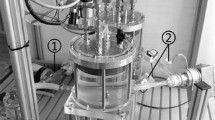Abstract
A general framework for designing an optimum control strategy for the Hemopump is described. An objective function was defined that includes four membership functions, each constructed based on the desired values of one of the four members: stroke volume, mean left atrial pressure, aortic diastolic pressure and mean pump rotation speed. The Hemopump was allowed to operate either at a constant speed or at two different speeds during a cardiac cycle. The goal was to maximise the objective function by varying the magnitude and timing of the pump speed. Using a canine circulatory model, it was demonstrated that, in general, different cardiac conditions or different clinical objectives require different operation parameters. For example, when a left ventricle with minor ischaemia was simulated, and the main objective was to increase stoke volume, the objective function was maximised, from a value of 0.877 when the pump was off, to 0.946 when the pump was operated at speed 2 (18 500-revolutions min−1). On the other hand, for a severely ischaemic heart, the optimum pump speed became speed 3 (20 000 revolutions min−1), which maximized the objective function to 0.943 (from 0.707 when the pump was off). The results also suggest that it is more beneficial to operate the Hemopump at two different speeds during a cardiac cycle (a higher speed during systole and early diastole, and a lower speed during late diastole) than to maintain a constant speed throughout the cardiac cycle.
Similar content being viewed by others
References
Klotz, S., Deng, M. C., Stypmann, J., Roetker, J., Wilhelm, M. J., Hammel, D., Scheld, H. H., andSchmid, C. (2004): ‘Left ventricular pressure and volume unloading during pulsatile versus nonpulsatile left ventricular assist device support’,Ann. Thorac. Surg.,77, pp. 143–150
Li, X., Bai, J., andHe, P. (2002): ‘Simulation study of the Hemopump as a cardiac assist device’,Med. Biol. Eng. Comput.,40, pp. 344–353
Loebe, M., Koster, A., Sänger, S., Potapov, E. V., Kuppe, H., Noon, G. P., andHetzer, R. (2001): ‘Inflammatory response after implantation of a left ventricular assist device: Comparison between the axial flow MicroMed DeBakey VAD and the pulsatile Novacor device’,ASAIO J.,47, pp. 272–274
McCarthy, P. M. (1995): ‘HeartMate implantable left ventricular assist device: bridge to transplantation and future applications’,Ann. Thorac. Surg.,59, pp. S46-S51
Meyns, B., Siess T., Laycock, S., Reul, H., Rau, G., andFlameng, W. (1996): ‘The heart-Hemopump interaction: A study of the Hemopump flow as a function of cardiac activity’,Artif. Organs,20, pp. 641–649
Nishimura, T., Tatsumi, E., Takachi, S., Taenaka, Y., Wakisaka, Y., Nakataki, T., Masuzawa, T., Takewa, Y., Nakamura, M., Endo, S., Nakata, M., andTakano, H. (1998): ‘Prolonged nonpulsatile left heart bypass with reduced systemic pulse pressure causes morphological changes in the aortic wall’,Artif. Organs,22, pp. 405–410
Parameshwar, J., andWallwork, J. (1997): ‘Left ventricular assist devices: current status and future applications’,Int. J. Cardiol.,62, pp. S23-S27
Saatty, T. L., andAlexander J. M. (1981): ‘Thinking with models: mathematical models in the physical, biological and social sciences’ (Pergamon press, 1981), pp. 148–151.
Siess, T., Meyns, B., Spielvogel, K., Reul, H., Rau, G., andFlameng, W. (1996): ‘Hemodynamic system analysis of intraarterial microaxial pumpin vitro andin vivo’,Artif. Organs,20, pp. 650–661
Song, X., Throckmorton, A. L., Untaroiu, A., Patel, S., Allaire, P. E., Wood, H. G. andOlsen, D. B. (2003): ‘Axial flow blood pumps’,ASAIO J.,49, pp. 355–364
Sweeney, M. S. (1999): ‘The Hemopump in 1997: A clinical, political, and marketing evolution’,Ann. Thorac. Surg.,68, pp. 761–763
Westaby, S., Frazier, O. H., Beyersdorf, F., Saito, S., Siegenthaler, M. P., Pigott, D. W., Catarino, P. A., andJarvik, R. (2002): ‘The Jarvik 2000 Heart. Clinical validation of the intraventricular position’,Eur. J. Cardio-thor. Surg.,22, pp. 228–232
WHO-Ish (1993): The Guidelines Subcommittee of the WHO-ISH Mild Hypertension Liaison Committee. 1993 Guidelines for the Management of Mild Hypertension. Memorandum from a World Health Organization—International Society of Hypertension Meeting,J. Hypertensions,11, pp. 905–918
Wu, Y., Allaire, P., Tao, G., Wood, H., Olsen, D., andTribble, C. (2003): ‘An advanced physiological controller design for a left ventricular assist device to prevent left ventricular collapse’,Artif. Organs,27, pp. 926–930
Author information
Authors and Affiliations
Corresponding author
Rights and permissions
About this article
Cite this article
He, P., Bai, J. & Xia, D.D. Optimum control of the Hemopump as a left-ventricular assist device. Med. Biol. Eng. Comput. 43, 136–141 (2005). https://doi.org/10.1007/BF02345135
Received:
Issue Date:
DOI: https://doi.org/10.1007/BF02345135




